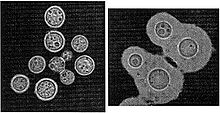- Cryptococcus gattii
-
Cryptococcus gattii 
Cryptococcus neoformans weakly encapsulated (left) as it appears in nature, and (right) rehydrated with thick polysaccharide capsule as it appears once in the lungs. Scientific classification Kingdom: Fungi Phylum: Basidiomycota Class: Tremellomycetes Order: Tremellales Family: Tremellaceae Genus: Cryptococcus Species: C. gattii Binomial name Cryptococcus gattii
(Vanbreus. & Takashio) Kwon-Chung & BoekhoutCryptococcus gattii, formerly known as Cryptococcus neoformans var gattii, is an encapsulated yeast found primarily in tropical and subtropical climates. Its teleomorph is Filobasidiella bacillispora, a filamentous fungus belonging to the class Tremellomycetes.
Cryptococcus gattii causes the human diseases of pulmonary cryptococcosis (lung infection), basal meningitis, and cerebral cryptococcomas. Occasionally, the fungus is associated with skin, soft tissue, lymph node, bone, and joint infections. In recent years, it has appeared in British Columbia, Canada and the Pacific Northwest.[1] It has been suggested[2][3] that global warming may have been a factor in its emergence in British Columbia. From 1999 through to early 2008, two hundred and sixteen people in British Columbia have been infected with C. gatti, and eight died from complications related to it.[4] The fungus also infects animals, such as dogs, koalas and dolphins.[3] In 2007, the fungus appeared for the first time in the United States, in Whatcom County, Washington[5] and in April 2010 had spread to Oregon.[6] The most recently identified strain, designated VGIIc, is particularly virulent, having proved fatal in 19 out of 218 known victims.[7]
Contents
Nomenclature
Cryptococcus gattii previously has had several different names including:
- Cryptococcus neoformans var gattii
- Cryptococcus bacillisporus
Summary
Cryptococcal disease is a very rare disease that can affect the lungs (pneumonia) and nervous system (causing meningitis and focal brain lesions called cryptococcomas) in humans. The main complication of lung infection is respiratory failure. Central nervous system infection may lead to hydrocephalus, seizures and focal neurological deficit.
Epidemiology
The highest incidences of C. gattii infections occur in Papua New Guinea and Northern Australia. Cases have also been reported in other regions, indicating its spread to India, Brazil, Vancouver Island in Canada, Washington State, and Oregon in the United States.
Unlike Cryptococcus neoformans, C. gattii is not particularly associated with human immunodeficiency virus infection or other forms of immunosuppression. The fungus can cause disease in healthy people.
Transmission
The infection is caused by inhaling spores. The fungus is not transmitted from person to person or from animal to person. A person with cryptococcal disease is not contagious.[8]
Symptoms
Most people who are exposed to the fungus do not become ill. In people who become ill, symptoms appear many weeks to months after exposure. Symptoms of cryptococcal disease include:
- Prolonged cough (lasting weeks or months)
- Sputum production
- Sharp chest pain
- Shortness of breath
- Sinusitis (cottony drainage, soreness, pressure)
- Severe headache (meningitis, encephalitis, meningoencephalitis)
- Stiff neck (prolonged and severe nuchal rigidity)
- Muscle soreness (mild to severe, local or diffuse)
- Photophobia (excessive sensitivity to light)
- Blurred or double vision
- Eye irritation ( soreness, redness)
- Focal neurological deficit
- Fever (delirium, hallucinations)
- Confusion (abnormal behavior changes, inappropriate mood swings)
- Seizures
- Dizziness
- Night sweats
- Weight loss
- Nausea (with or without vomiting)
- Skin lesions (rashes, scaling, plaques, papules, nodules, blisters, subcutaneous tumors or ulcers)
- Lethargy
- Apathy
Diagnosis
Culture of sputum, bronchoalveolar lavage, lung biopsy, cerebrospinal fluid or brain biopsy specimens on selective agar allows differentiation between C. gattii and C. neoformans.
Molecular techniques may be used to speciate Cryptococcus from specimens that fail to culture.
Serum and CSF Cryptococcal antigen testing is a useful preliminary test for Cryptococcal infection, and has high sensitivity for disease. It does not distinguish between different species of Cryptococcus.
Treatment
Medical treatment consists of prolonged intravenous therapy (for 6–8 weeks or longer) with the anti-fungal drug Amphotericin B, either in its conventional or lipid formulation. The addition of oral or intravenous flucytosine improves response rates. Oral fluconazole is then administered for six months or more.
Antifungals alone are often insufficient to cure C. gattii infections, and surgery to resect infected lung (lobectomy) or brain is often required. Ventricular shunts and Ommaya reservoirs are sometimes employed in the treatment of central nervous system infection.
See also
- Jenney A, Pandithage K, Fisher DA and Currie BJ. Cryptococcus infection in Tropical Australia. Journal of Clinical Microbiology 2004; 42(8): 3865-3868.
External links
- "Cryptococcus gattii - Research at the University of British Columbia". University of British Columbia. http://www.cryptococcusgattii.ca/.
- CDC publication: What Makes Cryptococcus neoformans a Pathogen?
- Kausik Datta, Karen H. Bartlett, Rebecca Baer, Edmond Byrnes, Eleni Galanis, Joseph Heitman, Linda Hoang, Mira J. Leslie, Laura MacDougall, Shelley S. Magill, Muhammad G. Morshed, and Kieren A. Marr (August 2009). "Spread of Cryptococcus gattii into Pacific Northwest Region of the United States" (PDF). Emerging Infectious Diseases 15 (8). doi:10.3201/eid1508.081384. http://www.bccdc.ca/NR/rdonlyres/BDE6C740-8A27-4C00-BC15-AA19E064AD92/0/CgattiispreadintoPNW.pdf.
References
- ^ "Cryptococcus gattii Q&A". Globe and Mail. 2007-02-10. http://www.theglobeandmail.com/servlet/story/RTGAM.20070210.wfungusQA0210/BNStory/Front.
- ^ Kidd, S.E.; F. Hagen, R. L. Tscharke, M. Huynh, K. H. Bartlett, M. Fyfe, L. MacDougall, T. Boekhout, K. J. Kwon-Chung,¶ and W. Meyer (December 7, 2004). "A rare genotype of Cryptococcus gattii caused the cryptococcosis outbreak on Vancouver Island (British Columbia, Canada)". Proceedings of the National Academy of Sciences of the United States of America 101 (49): 17258–17263. doi:10.1073/pnas.0402981101. PMC 535360. PMID 15572442. http://www.pubmedcentral.nih.gov/articlerender.fcgi?tool=pmcentrez&artid=535360.
- ^ a b Struck, Doug (2007-04-08). "Alien Invasion:The Fungus that came to Canada". Washington Post. http://www.washingtonpost.com/wp-dyn/content/article/2007/04/07/AR2007040700698.html?hpid=topnews.
- ^ "Deadly fungus migrates to Vancouver". Vancouver Sun. 2008-02-18. http://www.canada.com/vancouversun/news/story.html?id=e3500943-715a-4577-9554-a7bfe2ba8757&k=39482.
- ^ Rare, deadly tropical fungus moves into Whatcom County | KOMO-TV - Seattle, Washington | Local & Regional
- ^ Potentially deadly fungus spreading in U.S. and Canada http://www.reuters.com/article/idUSTRE63L66H20100422
- ^ New, Deadly Cryptococcus Gattii Fungus Found in U.S. http://news.nationalgeographic.com/news/2010/04/100421-new-fungus-cryptococcus-gattii-deadly-health-science/
- ^ Park, Alice (2010-04-23). "The 'Killer Fungus': Should We Be Scared?". Time. http://www.time.com/time/health/article/0,8599,1984337,00.html. Retrieved 2010-04-23.
Categories:- Yeasts
- Fungal diseases
Wikimedia Foundation. 2010.
